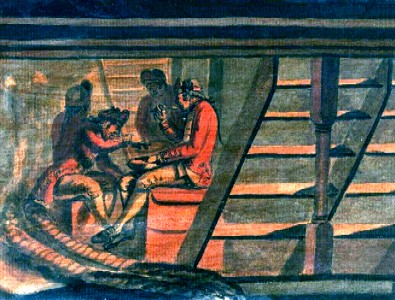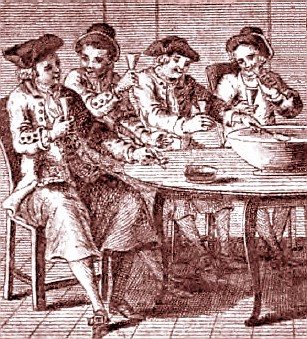-
Posts
5,186 -
Joined
-
Last visited
Contact Methods
-
Website URL
http://www.piratesurgeon.com
-
ICQ
0
Profile Information
-
Gender
Male
-
Location
Monroe, MI
-
Interests
Scholarly piracy, designing and creating haunted house rooms and props, movies, abstract thinking, abstruse thinking, obstructive thinking, ideating, random thinking, movies, cartoons, movies, movies scores, cycling, world peace and small furry dogs, movies, writing, drawing, personal skills training, gremlins and, of course, lest I forget, movies.
Recent Profile Visitors
-
One of the side effects that can occur is a drooping eyelid. If that happened, I would look even more piratical.
-
Well boys and girls, looks like i am out. I have bleeding in my right eye (a complication of long-term diabetes) which we've been trying to treat without surgery, but that has failed. So my doctor scheduled a victrectomy for me the week before the event and I won't be able to drive or fly for some time after it. (You're not supposed to move your head very much for several weeks or lie on your back because... well, I won't describe this operation itself, but you can look it up if you like. Don't do it if you're squeamish. ) Sorry about that. On another note, the first victrectomy is believed to have been performed by Dutch surgeon Anton Nuck in the late 17th century. So it has period roots. (I may have to expand my article on eye surgery...)
-
Whatever is decided, the food should probably be purchased on the way in. Unless things have changed dramatically since I was there, the closest big grocery store is back in Mobile. BTW, I will only be on site on Saturday and was sort of planning to eat at a restaurant Saturday night, possibly off island. I mention this only because as the sole vegetarian, I would probably be a PITA diner for Saturday dinner. And my hotel comes with a "full Southern breakfast", so I will likely only be eating lunch with the crew. Just FYI.
-
I found one for sale on ETSY... for $60+. (So maybe it's a project worth considering after all. ) (BTW, I reserve the right to be wrong about them being common in the GAoP because I haven't written the article that concerns eating utensils and dishes yet. I always learn things I didn't know and sometimes end up having to modify my views after a deep dive into a particular topic. They were found on the wreck of the Mary Rose, but that sank in 1545.)
-
They might well have gotten the idea from here. I was most fascinated with Dampier's Coconut back in 2008. BTW, a few years back, I wrote extensively on drinkware, including the coconut chalice. Although, to be fair, it was primarily something of the wealthy English, being made out of coconuts brought back to the mother country as I understand it. https://www.piratesurgeon.com/pages/surgeon_pages/booze3.html in addition, I wrote quite a bit about the fruit itself on my website. https://www.piratesurgeon.com/pages/surgeon_pages/food_type_fruit3.html#coconut
-
Here are some more after-period images related to dining on a ship. Sailors Eating, Mr. Midshipman Marryat arrives on his new ship, Frederick Marrat, 1820 Fold Down Mess Table, HMS Bounty II (original built 1787), wiki user BrokenSphere A couple of the HMS Victory (1758) from the website of Andy and Judi Patterson taken in 2017 at Portsmouth. Portsmouth., HMS Victory (1758), Gun Crew Work Station/Messroom Table, Andy Patterson Portsmouth, HMS Victory (1758), Messroom Plates, Andy Patterson
-
While I haven't found any period images that show eating from the GAoP itself, I do have some later period images. My impression is that the trencher (the square thing with the plate milled into the middle of it up there from the Victoria and Albert Museum) would be the most appropriate. These later images suggest bowls, however. (Note - the big bowl is a punch bowl, not a serving bowl. In fact, the smaller bowl near it may well be an individual punch bowl. Most images of sailors at table show them drinking punch rather than eating.) Four Marines eating Pease on board the Pallas, By Gabriel Bray, National Maritime Museum, Greenwich, London, Nov 1774 From The British Sailor's Loyal Toast, The British Tar in Fact and Fiction, 1738, p. 136
-

Cumulative Cross-Cultural Considerations & Corsair Crews
Mission replied to Picaroon Lagoon's topic in Captain Twill
Thinking on it, I remembered some other episodes of borrowing other cultural practices which argue against body decoration by sailors (albeit rather indirectly). They both come from buccaneer Lionel Wafer's account which focusing on his life among the Cuna natives of Panama. "...we had four Women to carry our Provision, and my Cloaths, which were only a Linnen Frock and pair of Breeches. These I saved to cover my Nakedness, if ever I should come among Christians again; for at this time I went naked as the Savages, and was painted by their Women; but I would not suffer them to prick my Skin [a real tattooing], to rub the Paint in, as they use to do, but only to lay it on in little specks." (A New Voyage and Description of the Isthmus of America, Lionel Wafer and George Parker Winslow, p. 58) "The four English Men with me were presently known and caress'd by the Ships Crew; but I sat a while cringing upon my Hams among the Indians, after their Fashion, painted as they were, and all naked but but only about the Waist, and with my Nose-piece (of which more hereafter) hanging over my Mouth. I was willing to try if they would know me in the Disguise; and 'twas the better part of an Hour before one of the Crew, looking more narrowly upon me, cry'd out, Here's our Doctor... I did what I could presently to wash off my Paint, but 'twas near a Month before I could get tolerably rid of it, having had my Skin so long stain'd with it, and the Pigment dried on in the Sun: And when it did come off, 'twas usually with the peeling off of Skin as well." [emphasis mine] (Wafer and Winslow, p. 64-5) Two points of interest here: First, the natives that Wafer was living with wore a crescent-shaped nose ring which covered part of their mouth. He noted that it had to be lifted when eating and drinking and was quite impractical - suggesting, in combination with the fact that he ran around in similar clothes (or lack thereof), that he had allowed himself to be tattooed as a part of looking like his hosts - he had really "gone native." Note particularly the comment about his concerns about coming "among Christians again." Second, I emphasize a point in the second quote to show that Wafer wanted to be rid of his "temporary" tattoo as soon as he was recognized as a member of the crew. This indicates it was unacceptable even among the sailors and suggests he wanted to fit in again when he got back among English sailors. Another sailor was apparently not quite so wise and "suffered them to prick their Skin" which he then wanted removed. "One of my Companions desired me once to get out of his Cheek one of these imprinted Pictures, which was made by the Negroes, his Name was Bullman; which yet I could not effectually do, after much scarifying [making small incisions and then drawing blood from them using heated bleeding bowls placed on the skin to create a vaccuum] and fetching off a great part of the Skin." (Wafer and Winslow, p. 136-7) -

Cumulative Cross-Cultural Considerations & Corsair Crews
Mission replied to Picaroon Lagoon's topic in Captain Twill
Incidentally, the English had tinder boxes for starting fires. If you'd like to know more, this topic may interest you: -

Cumulative Cross-Cultural Considerations & Corsair Crews
Mission replied to Picaroon Lagoon's topic in Captain Twill
And therein lies the problem. As when I first responded to your question about multi-lingual sailors, I don't know of any examples of cultural borrowing of the top off my head. But I don't really look for this sort of thing either. It does sort of remind me of an episode I love to bring up when someone starts talking about pirates wearing black, albeit for a very different reason. To wit: "I had then but one Bundle [of my possessions] left [after the pirates took the rest of his possessions], in which was a black Suit of Cloaths, and other things which this Gang [La Bouche, Cocklyn and Davis] had spared. They being gone out of the Cabin, a Pirate, who was tolerably sober, came in soon after, and seeing my Bundle, said, He would see what was in it; which in prudence I did not oppose. He __ then took out my black Cloaths, a good Hat and Wig, and some other Things. Wereupon I told him, 'Captain Cocklyn's Quarter-master had given them to me; and I hoped he would not deprive me of them; for they were of no service to him in so hot a Country, but would soon be of great use to me, as I should soon return to England." I had hardly done speaking, when he lifted up his broad Sword, and gave me a Blow on the Shoulder with the flat side of it; whispering at the same time these Words in my Ear, "I give you this Caution, never to dispute the Will of a Pirate: For, supposing I had cleft your Scull asunder for your Impudence, what would you have got by it but Destruction? Indeed you may flatter your self, I should have been put to death for killing a Prisoner in cold Blood; but assure your self my Friends would have brought me off on such an Occasion." I gave him thanks for his Admonition, and soon after he put on the Cloaths, which in less than half an hour after, I saw him take __ off and throw overboard. For some of the Pirates seeing him dress'd in that manner, had thrown several Buckets of Claret upon him." (William Snelgrave, A New Account of Some Parts of Guinea, 1724, pp. 235-7) Now, the reason I bring this up is because the pirate who took the black clothes was adopting a behavior which was different than what he would normally adopt - in this case, wearing more formal, black clothing. His fellow pirates responded by pouring wine on him so he removed the clothing and threw it over the side. He resisted adopting the new behavior because of peer pressure. I also recall an episode where some sailors were making fun of the type of hats the Dutch wore, indicating that they resisted borrowing Dutch behaviors. (Although I don't remember where that was, so you may want to discount it.) Anyhow, I am inclined to think that cultural (or even intercultural) borrowing was limited. However, I could well be wrong. The case of the buccaneers practicing bucaining seem to me to have been as much of necessity as trying something new. Dampier, OTOH, was an experimenter and tried all SORTS of things out of the norm, which sort of supports your theory. Although, most of the time, he appears to have gone back to his regular practices. In the end, people are people. Some are curious, some are not, some adventurous, some not, etc. The idea of people 'cross-cultural borrowing' is more esoteric than multilingualism. I was able to answer the multilingualism question by doing searches for relevant words. I don't see that being possible here. As a result, proving (or rather, disproving the idea that it never happened, which is how you would go about this) basically requires reading through the period sources to find examples to support it. So, sir, I challenge you to find the answer to your question and share it when you do. Below is a link to my page which lists the sailors' books from the period that I use to write articles about the topics that interest me. The majority of them can be found in PDF form for free on Google Books. (I make it easy by linking to them.) Read them. Find examples to support your theory. Even if you don't prove it, you will have learned a great deal about the sailors and pirates of the time and gained a fine understanding of life at sea during this time. As a result, you'll know far more than most people do. It's win/win. 🙂 https://piratesurgeon.com/pages/surgeon_pages/pirate_bibliography.html -
Traillink lists it as a paved trail, 13.3 miles long, so about 26 miles out and back. (I see what looks like gravel in one of the user photos, though. Although Traillink is usually really good about indicating when a trail is only partially paved.) My bike is a hybrid, so I primarily do paved and gravel bike trails, usually looking for those that I can do in an hour or two.
-
This explains a lot. It is not entirely surprising because the Portuguese were the first Europeans to explore India by way of the sea. "[Aden, Yemen, 1702] The people that came off to us in this boat were some of the top of the Town; as a priest, the Meobar or Chief of the Custom house, and the head Bannian or broker of the place, etc., the last of which was the best interpreter we had, he understanding a little Portuguese, or sort of Lingua frank [lingua franca - a common language used by people who speak different languages], which is spoke through all the trading parts of India almost, though but little or nothing of it here, this being a place of hardly any traffic of-late years, especially for Europeans, we being one of the first English ships that ever was in here, as twas said." (Francis Rogers, "The Journal of Francis Rogers", Three Sea Journals of Stuart Times, Bruce Ingram, ed., 1936, p. 165) Lingua franca is another important indication as to how discussion was facilitated and it comes up repeatedly in the sailor's literature. Surgeon John Covel, who sailed on the merchant ship London Merchant to the Mediterranean explained while at Carthage in 1673: "We were informed by our Guides, who spoke broken ltalian and lingua Franca (which is bastard Spanish, mixt with words of most trading nations), that from Cape Carthage to the Castle was once Terra firma, full of rubbish as the rest now is, but by an Earthquake it sunk down." (John Covel, "Diary", Early Voyages in the Levant, Thomas Dallam, ed., 1893, p. 122) Sailor Edward Coxere (mentioned previously) said that while he was in Porto Farina (modern Ghar al Milh, Tunisia): "I was the more esteemed of because I had the language [of Porto Farina] which was generally spoken, called lingua franca." (Edward Coxere, Adventures by Sea of Edward Coxere, 1946, p. 87) Dampier notes while at Pulo Condere (modern Con Son Island, Vietnam) that, "The Inhabitants of this Island are by Nation Cochinchinese, as they told us, for one of them spake good Malayan: which Language we learnt a smattering of, and some of us so as to speak it pretty well while we lay at Mindanao, and this is the common Tongue of Trade and Commerce (though it be not in several of them the Native Language) in most of the East India Islands, being the Lingua Franca, as it were, of these parts. I believe 'tis the vulgar Tongue at Malacca, Sumatra, Java, and Borneo; but at Celebes, the Philippine Islands and the Spice islands, it seems borrowed for the carrying on of Trade." William Dampier, A New Voyage Round the World, 1699, p. 394-5) There are some others, but you see the point. Like everything else, communication between sailors and others was accomplished via several methods. But there does not seem to have been a formal method, nor did everyone speak all the different languages required to communicate with each other. Some people, like Coxere, were adept at learning new languages and others weren't. Sailors of different nations seem to have primarily talked though such gifted men. In the interest of trade, foreign nations learned enough of a language to carry on conversations so they could sell their goods. So it was all done just like it is today, really.
-
Informational rabbit holes. Once I get started, I can't resist them, especially when the information I find teaches me something I didn't know. I can't tell you how many times questions like this have led to my writing articles on my website. This one doesn't really fit, but you can never tell...
-
This is interesting because it indicates how the East India Company tried to deal with the language problem at the Cape of Good Hope. It is told as a history without specifics, so the dates are uncertain - it only says this all began 'in Elizabethan times', but it was likely in the early 1600s. It is worth noting that sailor Hamilton's book contains a variety of factual errors and should probably be taken with a grain of salt. "A few Years after they had left it, the English East-India Company considering what Importance a Port would be of to their Shipping, both in their outward and homeward bound Passages to and from India, were resolved to make another Trial for a Settlement there, and, in order to accomplish their Design, obtained a Reprieve for three condemned Male factors [men in charge of factories aka. warehouses], to be carried thither in order to learn the Language, to serve for Interpreters, and to inspect, as far as they could, into the Manners and Customs of the native Hottentots, and of the Product and Commerce of the Country; After they had been there three Years without being able to learn any of their Language, or to teach any of the Natives a Word of English, a Ship was ordered, in her Passage from India, to call there, to know what was become of these three Persons, and arriving there, found them all alive, but very tired with their manner of living... Some Years after the Experiment was made on the aforesaid Criminals, an English Ship coming there for Water and Provisions, in their Way homeward to England, the Captain had the Curiosity to detain a Youth that came on board his Ship, and, being ready to sail, carried him to England, where he staid some Years, clothed well after the English Fashion, and kept at School to learn to speak and read English; and, when the East-India Company thought him well enough qualified to serve for an Interpreter, they sent him back to his own Country, very well clothed. Assoon as he appeared ashore among his Friends and Relations, he pulled off his English Apparel, and put on his Country Habit..." (Alexander Hamilton, A new account of the East Indies, 1746, p. 2-3)


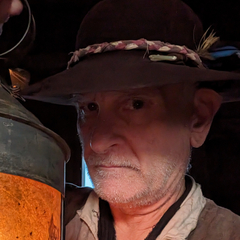
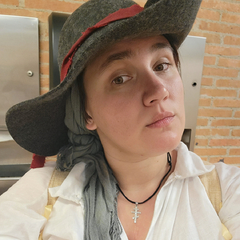
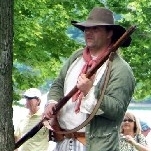
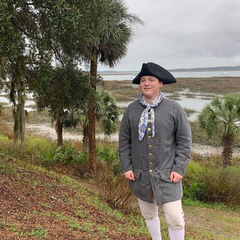



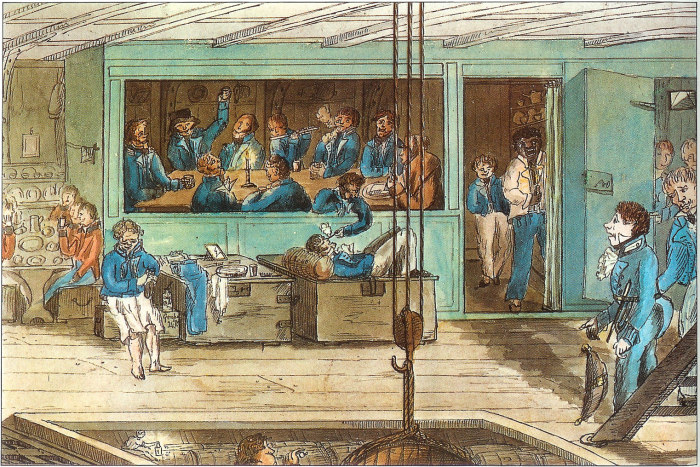

GunCrewWorkStationMessroomAndyPatterson2017.jpg.dfa19915420a02f5b514f9c33eca9bdd.jpg)
MessroomPlatesAndyPatterson2017.jpg.0c1f1556b1dab7421118cda6aa803354.jpg)
